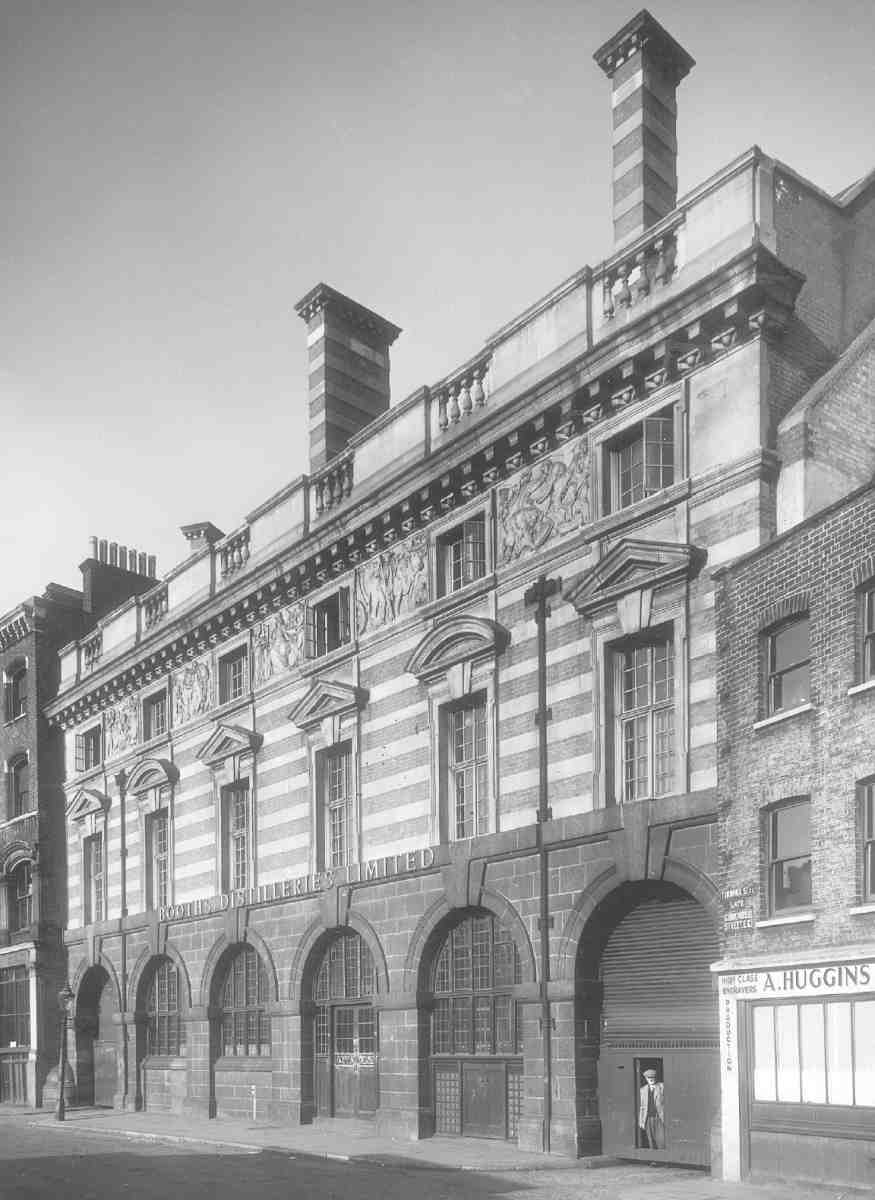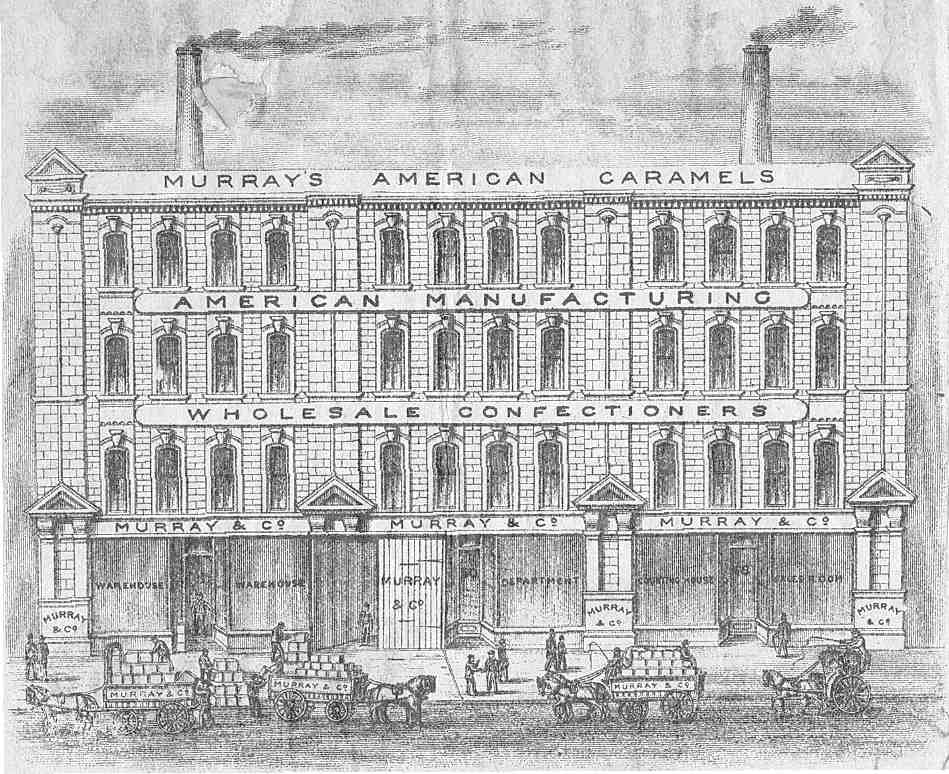Turnmill Street got its name from mills and milling (predictably enough). The mills were water mills turned by the nearby River Fleet which runs north to south. This once significant river was covered over in the 19th century and now forms an important part of London’s sewerage system, helping to wash effluent down towards the main collection sewers running parallel to the Thames. The mills were not confined to corn. There were mills for grinding lead, and others for grinding pigments used for dying clothes.

Turnmill Street was also known as Turnbull Street occasionally, which reflected the cattle trade which was the predominant trade of the Smithfield area. There were livestock markets at Smithfield from Norman times.
In the 19th century the area became infamous for its slums. I have written a separate blog post on “Little Hell” the slum at the top of Turnmill Street.
But industries industries moved in as well. Booth’s Gin became established in Turnmill Street in the 1700s and gradually expanded to take over much of the land between Turnmill Street and Britton Street for its factory and warehousing. Booth’s Gin operated in and near Turnmill Street for over 200 years and only left in the 1970s.

Turnmill Street was hugely affected by the arrival of the Metropolitan Railway in the 1860s – one side of the street was simply demolished.
Turnmill Street became a centre for the engineering and metalworking trades in the later years of the 19th century. There were businesses making scientific instruments and precision tools, but they were outnumbered by businesses in the printing trade. In the early 1900s businesses in Turnmill Street included printers, bookbinders, engravers, type founders, photo-etchers and chromo-lithographers. Before the Second World War there were also makers of printing equipment, stereotypers, stationers, ticket writers and envelope addressers. This concentration of engineering and printing trades continued into the mid-1970s.
There was also RS Murray, manufacturers of confectionery, who started out in 1884 in Turnmill Street. Murray’s was the first company in Britain to manufacture caramels, suckable sweets invented in America. (But they did not have any connection with the celebrated Murray Mints which was in fact a brand launched by Trebor in 1944). Murray’s expanded into Britton Street and Clerkenwell Road and only finally left the area in the 1930s.

Turnmill Street now starts at Nos. 63-64. This is because Turnmill Street used to be much longer until it was cut off by the new Clerkenwell Road built in the 1870s.
Nos. 63-64 Turnmill Street is an entirely new building called ‘Turnmill’ which runs all the way to Broad Courtyard. For many decades the site was occupied by Booth’s Gin as a warehouse for their wine department. In the 1970s it was turned into ‘Turnmills’, a popular club and haunt for the famous – Michael Jackson and Madonna spent time there – and for the infamous – the gangster ‘Mad’ Frankie Fraser was shot and wounded there in 1991.

No. 66 Turnmill Street is a red- and stock-brick building of the 1880s. But that’s only the façade. The buildings itself is all new build. No. 69 is an entirely new building.
No. 75 Turnmill Street forms a single development with Thackery Court and Nos 13–16 Britton Street carried out in 2003. It replaced a former newspaper distribution centre in Turnmill Street. It contains flats, some mews houses, and some ground-floor commercial units in Turnmill Street. It is not all new – Edwardian warehouses in Britton Street were incorporated. The main feature on Turnmill Street is the undulating façade which is clad in horizontally banded zinc sheets supported on irregularly spaced columns.

No. 80 Turnmill Street is a massive new building replacing Nos. 76-86 Turnmill Street. It is a 1975 office block called ‘Laden House’, which itself was a redevelopment of some of Booth’s Gin’s far-spread Turnmill Street empire.

Nos. 87-88 Turnmill Street look like they might be a vestige of the olden days. But the neo-Georgian front is just that – a front – and it’s a shop and office development built in 1981.
Next door, No. 89 Turnmill Street is genuinely a historic building. It was built in 1874 as workshops for a manufacturer of scientific instruments, and later occupied by pyjama manufacturers. It was refurbished in 2006 to create a bar and restaurant on the ground floor and flats above. It’s a handsome building but currently covered in scaffolding and canvas, so I haven’t been able to photograph it.
Nos. 91-92 Turnmill Street followed the example of Nos 87-88 Turnmill Street. It’s a genuine old building at the front, but everything behind the front walls was reconstructed in the early part of this century.
The slightly forbidding building on the corner with Benjamin Street, done up in dark red bricks, and looking like the sort of building which would have mad relatives locked in the attic, was built for a toy manufacturer in 1905.

On the other side of Benjamin Street is Nos. 94-98 Turnmill Street, which is a bright-looking, concrete-framed building built in the 1960s.
Then almost at the corner is Nos. 99-100 Turnmill Street, another handsome-looking building. I suspect, going by the Dutch-like fake gables, that the architect was going for a Queen Anne Revival Style look.

Nos. 32 to 35 Cowcross St and Nos. 101 and 102 Turnmill St were built as a public house flanked by warehouses. There have been former ‘Castle’ taverns on the site. One landlord found himself in the fortunate position of lending some money to George IV to settle his gambling debts, when the king was out cockfighting and found himself a bit short. In return George IV granted him a pawn brokers license for the tavern. The present ‘Castle’ was built in 1865-7 by John Bishop, who then became landlord of the pub. In the photo you can see the pawn broker sign.

